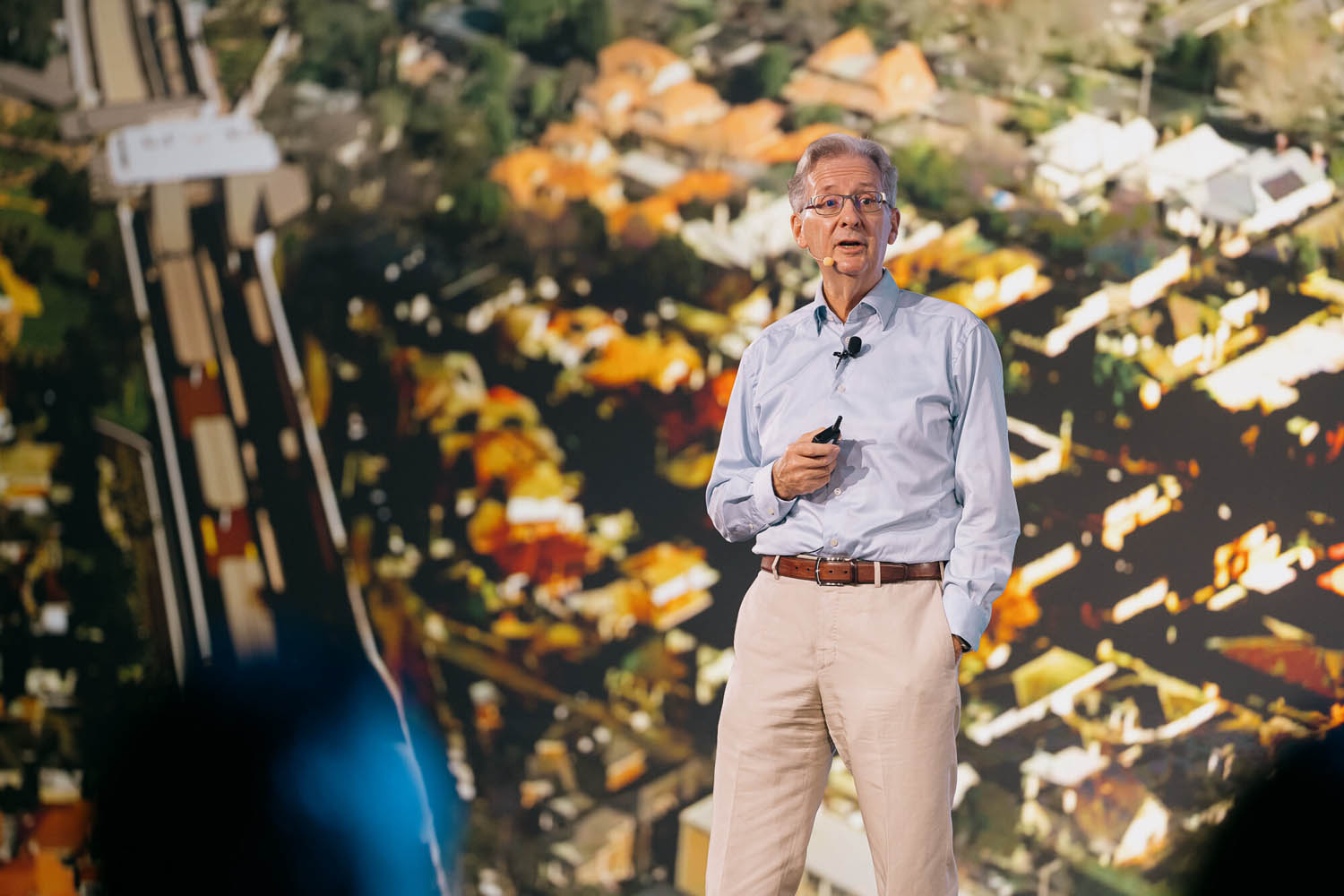Digital twins, AI, infrastructure intelligence and subsurface capabilities were among the key themes discussed at Bentley Systems’ annual conference, held at the iconic Marina Bay Sands Hotel in Singapore. Martyn Day reports
Singapore is a city, but it also feels part-machine. To be strictly accurate, it’s a city-state, one of only three left in the world, – along with European cousins, Monaco and the Vatican.
Singapore’s machine-like qualities derive from the density of its infrastructure. It occupies 682.7 square kilometres, criss-crossed by 3,000 kilometres of roads and 200 kilometres of rail on which some 3 million users travel daily. That’s made it a Mecca for a company like Bentley Systems, according to Greg Bentley, CEO of the infrastructure engineering software company. Plus, much of Singapore’s infrastructure has already been digitised. Here, the benefits of going digital for planning, building, operations and maintenance can be seen everywhere — in the city-state’s public transport, roads and buildings.
The efficiency metrics speak for themselves. In 2022, the MRT (Mass Rapid Transit) train network clocked 2.48 million train-km between delays. There was just one breakdown exceeding 30 minutes that year, across both the MRT and LRT (Light Rail Transit) networks.
Find this article plus many more in the September / October 2023 Edition of AEC Magazine
👉 Subscribe FREE here 👈
This remarkable reliability is down to regular maintenance and generous incentives to operators. Arriving in Singapore just as the UK government kiboshed half of the planned HS2 project because we couldn’t manage the budget properly, it wasn’t hard to feel as if the UK as a nation is rapidly devolving. And that’s without mentioning the UK’s water treatment plants, which now use rivers and beaches as part of the general sewage infrastructure.
Such situations are further complicated by a profound skills gap, as Greg Bentley pointed out to attendees at the company’s annual Year In Infrastructure (YII) event held at the Marina Bay Sands Hotel in mid-October 2023. The infrastructure industry, he said, faces a 10% engineering resource capacity gap, leaving it struggling to meet demand for maintenance work and new projects.
Against this backdrop, doing more with less remains as critical as ever, perhaps even more so — which to Bentley’s mind, means adopting digital tools that can deliver new efficiencies. In line with that thinking, project submitters at this year’s event were asked to quantify the engineering savings they had achieved by adopting digital processes. Among those able to make that calculation, the median savings were 18%.
Switching tack to look at AI, and the hype surrounding it, Greg Bentley acknowledged that generative AI would be a big theme at the event, with a particular focus on what he terms ‘infrastructure intelligence’. The company plans to roll out a range of capabilities and strategies to get the most value out of infrastructure engineering data, he said, and AI is part of this. “Generative AI is a reminder that there’s lots of unrealised value to be compounded from the data we’re accumulating, even in ways we couldn’t anticipate.”
Changes underway
In 2020, Bentley Systems went public and listed on NASDAQ. Between Covid, retirements, and employees cashing out, the executive team has been transformed since that time, to the extent that it almost feels like a different company now.
This year, Kristin Fallon joins Bentley as chief marketing officer, coming from GE Healthcare. Chris Bradshaw who was CMO, now takes the role of chief sustainability officer. Oliver Conze joins as senior VP, Bentley Infrastructure Cloud, and Colin Ellam becomes chief executive officer of Cohesive, Bentley’s global systems integrator.
Last year saw founder and all-round mensch Keith Bentley retire, with Julien Moutte taking the CTO role and Mike Campbell joining as chief product officer from PTC, a mechanical CAD and PLM software developer. The net result of these changes is a resurgence of focus and energy. There certainly feels like there’s a new velocity and purpose within the company.
One of Bentley’s key new areas of focus is subsurface capabilities. In 2021, the company acquired Seequent, a leading 3D modelling software for geosciences, for $1.05 billion. This has led the company into a whole new underworld. Digital twins and infrastructure projects, after all, are often more about what’s underground, rather than above it.
This year, Bentley Systems announced its acquisition of Flow State Solutions, a provider of geothermal simulation software. This move reinforces Seequent, to further boost the company’s claim of having the most comprehensive suite of subsurface tools in the geothermal industry.
Combining the capabilities of Flow State Solutions’ Volsung portfolio with Seequent’s expertise, the acquisition creates an end-toend solution for reservoir analysis, asset development and optimisation. By integrating the detailed subsurface models created in Seequent’s Leapfrog Energy with Flow State Solutions’ simulation environment, meanwhile, users can develop a full understanding of geothermal asset performance.
When it comes to digital twins, one of the key technology announcements this year was that the iTwin format will be built into Bentley Systems’ core modelling and drawing platform, MicroStation. Because MicroStation is the fundamental platform that underpins all of Bentley Systems’ open platforms, this makes iTwin workflows an alternative to file-based DGN. In other words, users are no longer required to specifically save/convert projects to iTwin workflows. This may not sound like a huge change, but it is a fundamental shift that will assist in moving customers from file-based working to streamed, rich databases.
As Bentley CTO Julien Moutte explained: “MicroStation remains the MicroStation that users have always used. It’s based on the power platform, it produces DGN files. What’s new is that it includes a plug-in that can synchronise in parallel to what you’re doing with an iTwin locally on your machine. It’s not a cache. It’s not a choice of file versus databases. It’s the file and the database being created and synchronised at the same time. So, when you design, you produce a DGN file, but you also produce an iTwin, and it’s transparent for you as a user.”
While the DGN remains “the source of truth”, he said, “when you check your DGN back into ProjectWise, then ProjectWise and MicroStation collaborate with each other and ProjectWise knows that it doesn’t need to convert the DGN to an iTwin in the cloud, as it was already done on the machine. When you push your changes to your iTwin, it’s as if you are pushing your commits to a Git-hub style repository, that goes into the cloud, and that keeps your iTwin up to date. But the DGN remains the source of truth.”
With more data being stored in the iTwin format, Bentley now faces new opportunities to apply AI across entire projects and drive new automation
So why keep DGN, in that case? Because a lot of users still need DGN and Bentley Systems doesn’t want to disrupt their workflows, he said. “What we want to do is to make sure that it’s as easy as possible for customers to get started with iTwin. The digital twin should be produced transparently and systematically for users. With iTwin, there’s a lot of value that we can then add on top of that comprehensive database, as it has a lot of new capabilities, and a lot of new features are going to be exposed on top of the iTwin and the iModels.”
As a result, customers will get many new features that will only be possible because they have a database and a new kind of data format. And they will have the possibility to use those new features, together with MicroStation, because the iTwin and the DGN are on the same machine. “For the users, it’s completely transparent. They get the iTwin created, and they have a lot of new features that will give them a reason to start to use the iTwin more and more,” he explained.
With the industry moving from files to databases, this is a significant move for Bentley. Files are big lumps of data and every designer from each discipline generates their own files. Databases, by contrast, are transactional and easily shared, in order to hold one version of the truth. By moving to a modern database infrastructure, data can flow between all project participants, through the managed environment, while tracking changes, with high throughput at component level. By ensuring there’s a local iTwin copy, it enables users to work offline, not having to always be connected to the cloud/project management host. But when it does connect, it can synchronise with all the project information.
So what are the benefits? As Moutte explained, “For a user, as you work with MicroStation, and you have this iTwin being created locally, you get features that are all ‘Git-like’ with your design.” In other words, they can see their list of element design changes (history); they can review them; and they can push those changes to the iTwin (collaborate), exactly like a software engineer working with source code. Trying to make DGN work this way would be clumsy, because it was never designed to do that.
“It will be possible to work with another designer such as an (AI) co-pilot, analysing the model that you are creating, this is done while sharing all the changes that you do in the iTwin,” Moutte continued. “Being able to understand your design intent and try to automate and provide recommendations is much easier and much more efficient to do on the model and the database, than doing this on top of a DGN file. We have the full context. We have all the data from all the disciplines. We can understand the impact of changes that others have made. So that’s why I’m saying that you will have new features coming into MicroStation, made possible because we have the iTwin and iModel created behind the scenes, versus what you’re doing today.”
It’s worth pointing out that Bentley has open-sourced its iTwin format. This is another big move, especially in an industry that has previously locked customer’s data into proprietary formats and leveraged business models off of that.
AI and automated drawings
Artificial intelligence featured heavily at YII this year. Attendees were given many examples of customers already using AI in the inspection and analysis of infrastructure projects, such as bridges and dams. In the Transport category, this was a bit of a repeat from last year’s AI-related presentations, but the one big difference was that more of Bentley’s customer base are obviously using the technology now. There were more far-reaching potential use cases provided for AI this year, especially in discussions of AI co-pilots aiding designers in the modelling process and in automating drawing output.
“Right now, this is research,” said Moutte. “It will be a discovery, as we try to understand what the places are where we can bring the most value. Right now, what we’re exploring is how we can help designers while they do the design, to explore more alternatives and understand why those alternatives could be more beneficial.”
Some of those capabilities already exist in some of Bentley’s products, he said, but they are based on generic algorithms that try to come up with the best possible design in one given location.
“What we want is the co-pilot to work a lot more with the engineer, as some kind of cooperation game, where the designer and the agent are working ‘against’ the design space,” he said.
In other words, this is a process of examining the searchable space for possible designs and alternatives and identifying the best one by combining the expectations of both. This was not something that Bentley was doing before, he said.
“We were searching for the best design, but we were not taking the feedback from the designer into consideration. So the idea of a co-pilot is really to do that. The designer knows what they want to do, which suggestions they will reject. While AI might find an optimal solution, it may look bad, or not be convenient, or not be usable – so the designer can make choices and guide the AI on optimising towards that optimal solution.”
At AEC Magazine, from talking to design IT managers, we found that one of the biggest wish list items for BIM users is truly automated 2D drawings. There are already a number of firms working on this, such as SWAPP and Graebert. One of the key areas for research, mentioned by Bentley’s CTO, was indeed the application of AI to automate 2D output, drawing sheets, title blocks, views, dimensions, details and so on.
Moutte elaborated on the company’s research into automated drawings. “What we’re looking at right now is how can we automate the production of drawings for site engineering first, because there’s a lot to be done there. And how can AI models be trained to look at the past designs and past drawings and try to understand the style, requirements, the layout etcetera, and try to automate some of those drawings,” he said. “Now producing drawings for any kind of design is a challenging task, because you need to have a lot more
data first to learn each kind of drawing that you will need to produce for all the different disciplines. You need to understand each domain’s requirements, because a structural engineer, an architect, a mechanical engineer, electrical – all those drawing types – are different. Also, to start with, you need to have the model with the necessary level of detail to produce those drawings.”
A cure for sceptics
For us at AEC Magazine, the really good thing about Bentley’s Year In Infrastructure event is the opportunity to meet with the customers who use the technology — seeing their projects and understanding the scale at which the software is being used. On top of that, we get to hear about the company’s development directions and how it plans to drive digitalisation further, extract benefits and shine a light on dark project data.
For those who have doubts about the benefits of digital twins, YII is a certified cure. Bentley’s advanced customers model roads, railways, water treatment plants, tunnels, airports, train stations, bridges, power substations and cities — all managed assets with inspection and maintenance needs. So much of the development work that Bentley showcases is about making the most of digital twin data to optimise real-world performance.
Creating digital twins is now easier, and a collaborative system architecture certainly helps in that process. DGN isn’t dead by any means, but it’s clearly destined to become a legacy format. It’s still amazing that Bentley has only altered the format twice in 36 years; the most recent being in 2001, when V8 was released. By contrast, Autodesk AutoCAD’s DWG has changed 18 times since its first version was released.
With more data being stored in the iTwin format, Bentley now faces new opportunities to apply AI across entire projects and drive new automation. While all this may sound a little space age to the uninitiated, the recognition that drawings are not going away but could actually benefit from the application of AI will possibly broaden Bentley’s appeal to the mass BIM AEC market. After all, there are many companies here searching for the same benefits. We will wait and see what develops.
Singapore digital twin benefits

At the 2023 Year in Infrastructure conference, a number of impressive Singapore-based projects were showcased that use digital twin technology to optimise decisionmaking and operations.
PUB, the Singapore national water agency, is collaborating with Bentley Systems on a research project funded by the Singapore National Research Foundation. This system is intended to detect and localise water system anomalies and leaks in near real-time. Relying on a digital twin, AI-based predictive models assist in hydraulic network model calibration and simulation.
SMRT Trains, the leading multimodal public transport operator in Singapore, is using AssetWise Linear Analytics software as the basis for its Predictive Decision Support System, allowing it to meet service reliability targets through optimised maintenance deployments.
Meanwhile, Singapore’s Land Transport Authority has utilised Bentley Systems’ EMME and DYNAMEQ mobility digital twin software for long-term and short-term planning requirements, including operational traffic models for traffic impact and scheme analysis.
The Singapore Land Authority has been a leader in digital twin adoption, with Dr. Victor Khoo, its Director of Survey and Geomatics discussing Singapore’s digital twin journey. This has included the creation of a 0.225-metre accurate nationwide reality mesh, derived from aerial surveying, which is shared with multiple agencies and research institutes to support Singapore’s sustainability initiatives.








